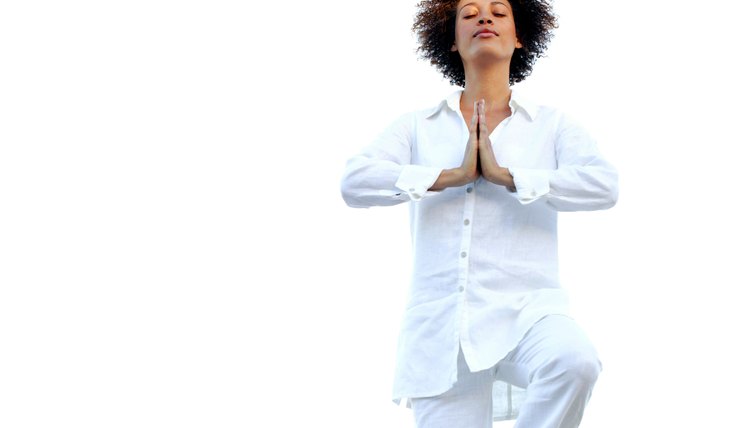Chinese Breathing Exercise

Traditional Chinese Medicine, also referred to as TCM, is an ancient medical system that has been practiced for thousands of years. It is based on the belief that the proper flow of Qi, also known as Chi -- or the life force energy -- plays a crucial role in health and well-being. Qigong is a Chinese energy practice that involves specific, therapeutic breathing exercises. Qigong breathing exercises may help stimulate the flow of Qi, improve lung capacity and enhance your overall health.
Basic Qigong Breathing
The basic Qigong breathing technique focuses on conscious, deep abdominal breathing. Most people unconsciously breathe from their chests, resulting in short, shallow, inefficient breaths. Abdominal breathing promotes increased oxygen intake and cultivates Qi. Sit in a straight-backed chair with your neck and spine in alignment. This promotes a healthy flow of Qi throughout your spinal column. Place your hands on your abdomen. Close your eyes and simply notice your breath for a few moments. Then take a deep, conscious inhalation, filling your abdomen with air. Pause at the top of your inhalation to collect your Qi, then slowly exhale, emptying all of the air from your abdomen and lungs. Breathe in this manner for several minutes.
Dantian Breathing
Dantian breathing is another fundamental Qigong breathing exercise. This exercise focuses on directing the flow of Qi into your lower dantian -- the energy center located just below your belly button. Stand with your feet shoulder-width apart or sit in a chair, keeping your spine straight and your shoulders relaxed. Place two fingers on the lower dantian and focus on the energy located in this area for a moment. Release your hands to your sides. Gently press the tip of your tongue onto the roof of your mouth behind your teeth. Close your eyes, smile softly and breathe in through your nose, focusing on the flow of air in and out of your lower dantian. Practice this exercise for at least 15 minutes daily.
Reverse Abdominal Breathing
Reverse abdominal breathing is an advanced Qigong breathing exercise, where you practice the basic Qigong breathing technique in reverse. As you inhale, contract your abdominal muscles. Hold the contraction for a moment, then exhale, consciously expanding your abdomen and relaxing the muscles of your rib cage. The action may feel awkward at first but will become easier and more natural with practice.
Walking Qigong
Although there are many variations of Walking Qigong, the exercises essentially involve consciously coordinating your breath with your steps as you walk. Perform this exercise outdoors to connect with the flow of Qi in nature. As you step forward with your right foot, breathe in, taking two short inhalations through your nose. Step forward with your left foot and exhale out of your mouth in one long, smooth exhalation. Continue this pattern for a few minutes, then reverse, inhaling twice as you step forward with your left foot and slowly exhaling as you step forward with your right foot.
References
- Traditional Chinese Medicine World Foundation: What is Traditional Chinese Medicine?
- Pacific College of Oriental Medicine: The Breathing Benefits of Traditional Chinese Medicine
- Chikung-Unlimited: Diaphragmatic Breathing Techniques & Other Breathing Exercises
- The Power of Practice: Lower Dantian Breathing
- Qigong for Treating Common Ailments: The Essential Guide to Self Healing; Xiangcai Xu
- The Healing Promise of Qi: Creating Extraordinary Wellness Through Qigong and Tai Chi; Roger Jahnke
Writer Bio
Ashley Miller is a licensed social worker, psychotherapist, certified Reiki practitioner, yoga enthusiast and aromatherapist. She has also worked as an employee assistance program counselor and a substance-abuse professional. Miller holds a Master of Social Work and has extensive training in mental health diagnosis, as well as child and adolescent psychotherapy. She also has a bachelor's degree in music.
